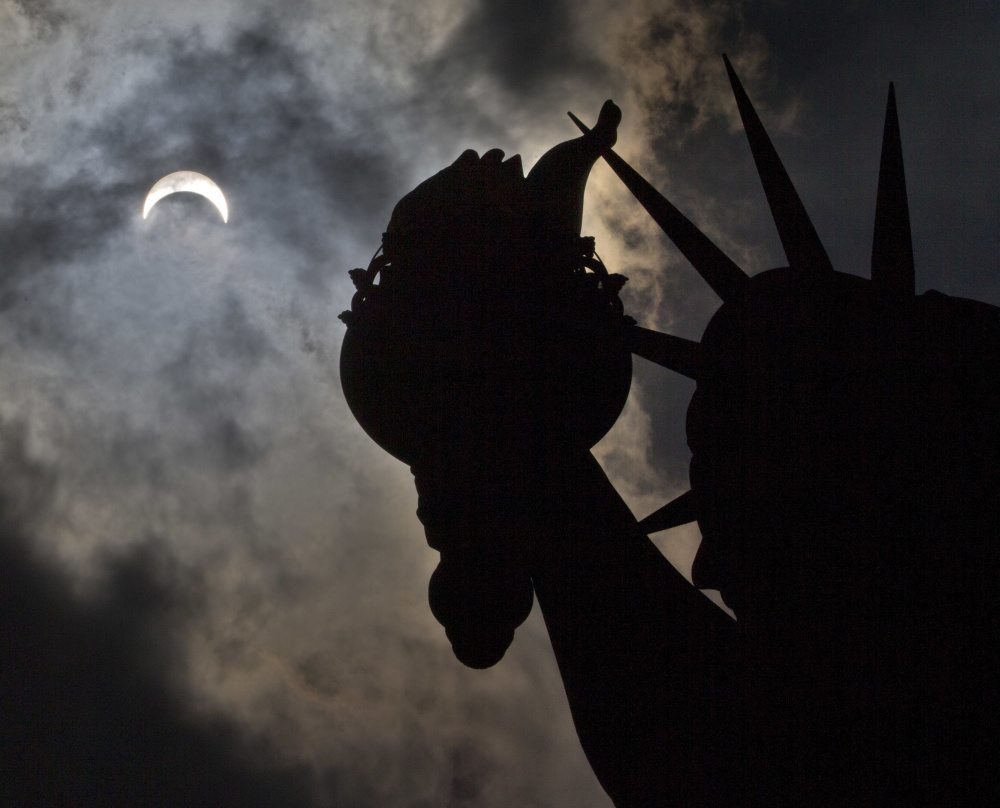The stars came out in the middle of the day, zoo animals ran in agitated circles, crickets chirped, birds fell silent and a chilly darkness settled upon the land Monday as the U.S. witnessed its first full-blown, coast-to-coast solar eclipse since World War I.
Millions of Americans gazed in wonder at the cosmic spectacle, with the best seats along the so-called path of totality that raced 2,600 miles across the continent from Oregon to South Carolina.
“It was a very primal experience,” Julie Vigeland, of Portland, Oregon, said after she was moved to tears by the sight of the sun reduced to a silvery ring of light in Salem.
It took 90 minutes for the shadow of the moon to travel across the country. Along that path, the moon blotted out the midday sun for about two wondrous minutes at any one place, eliciting oohs, aahs, whoops and shouts from people gathered in stadiums, parks and backyards.
It was, by all accounts, the most-observed and most-photographed eclipse in history, documented by satellites and high-altitude balloons and watched on Earth through telescopes, cameras and cardboard-frame protective eyeglasses.
In Boise, Idaho, where the sun was more than 99 percent blocked, the street lights flicked on briefly, while in Nashville, Tennessee, people craned their necks at the sky and knocked back longneck beers at Nudie’s Honky Tonk bar.
Passengers aboard a cruise ship in the Caribbean watched it unfold as Bonnie Tyler sang her 1983 hit “Total Eclipse of the Heart.”
Several minor-league baseball teams – one of them, the Columbia Fireflies, outfitted for the day in glow-in-the-dark jerseys – briefly suspended play.
At the White House, despite all the warnings from experts about the risk of eye damage, President Trump took off his eclipse glasses and looked directly at the sun.
The path of totality, where the sun was 100 percent obscured by the moon, was just 60 to 70 miles wide. But the rest of North America was treated to a partial eclipse, as were Central America and the upper reaches of South America.
Skies were clear along most of the route, to the relief of those who feared cloud cover would spoil the moment.
“Oh, God, oh, that was amazing,” said Joe Dellinger, a Houston man who set up a telescope on the Capitol lawn in Jefferson City, Missouri. “That was better than any photo.”
NASA reported 4.4 million people were watching its TV coverage midway through the eclipse, the biggest livestream event in the space agency’s history.
“It can be religious. It makes you feel insignificant, like you’re just a speck in the whole scheme of things,” said veteran eclipse-watcher Mike O’Leary of San Diego, who set up his camera along with hundreds of other amateur astronomers in Casper, Wyoming.
After the celestial spectacle, eclipse-watchers heading home in Tennessee and Wyoming spent hours stuck in traffic jams. In Kentucky, two women watching the eclipse while standing on a sidewalk were struck by a car, and one has died, authorities said.
The Earth, moon and sun line up perfectly every one to three years, briefly turning day into night for a sliver of the planet. But these sights normally are in no man’s land, like the vast Pacific or Earth’s poles. This is the first eclipse of the social media era to pass through such a heavily populated area.
The last coast-to-coast total eclipse in the U.S. was in 1918, when Woodrow Wilson was president. The last total solar eclipse in the U.S. was in 1979, but only five states in the Northwest experienced total darkness.
The next total eclipse in the U.S. will be in 2024. The next coast-to-coast one will not be until 2045.
Send questions/comments to the editors.



Success. Please wait for the page to reload. If the page does not reload within 5 seconds, please refresh the page.
Enter your email and password to access comments.
Hi, to comment on stories you must . This profile is in addition to your subscription and website login.
Already have a commenting profile? .
Invalid username/password.
Please check your email to confirm and complete your registration.
Only subscribers are eligible to post comments. Please subscribe or login first for digital access. Here’s why.
Use the form below to reset your password. When you've submitted your account email, we will send an email with a reset code.